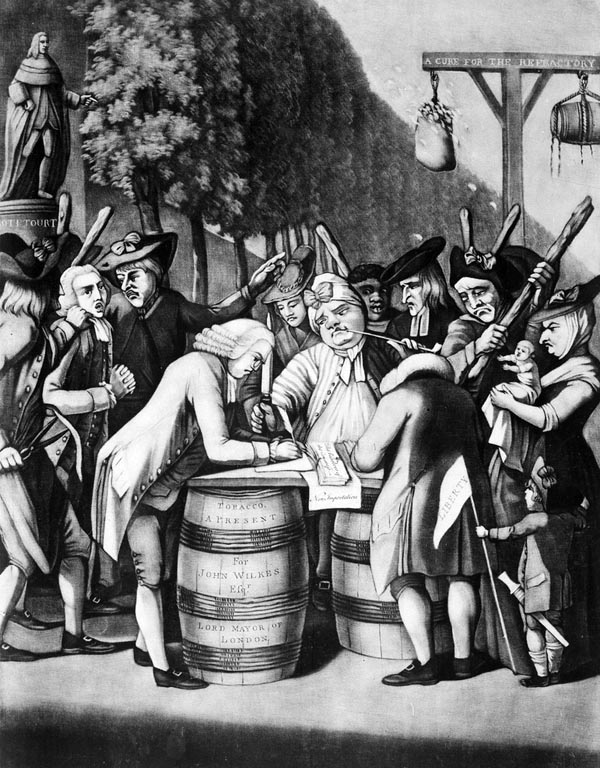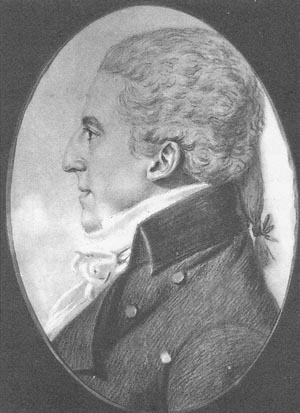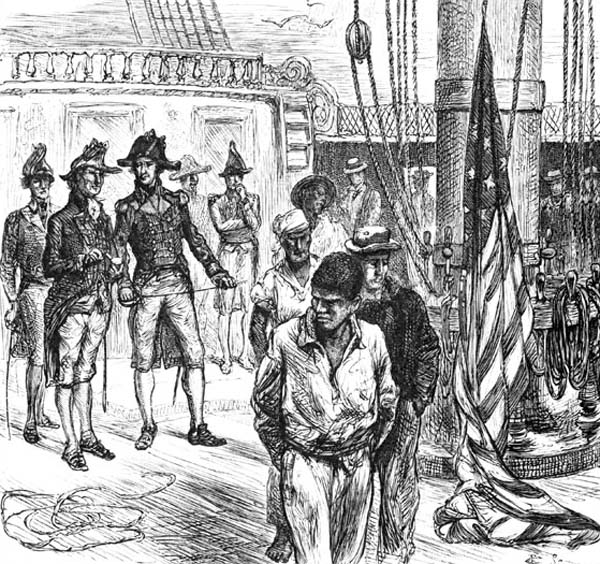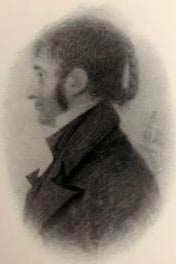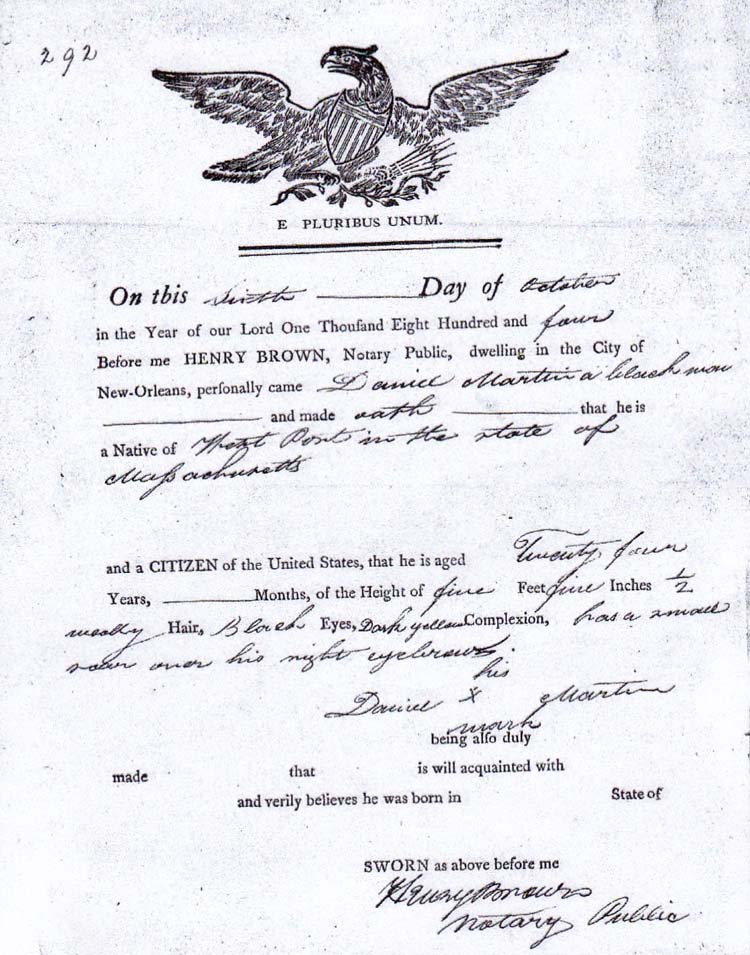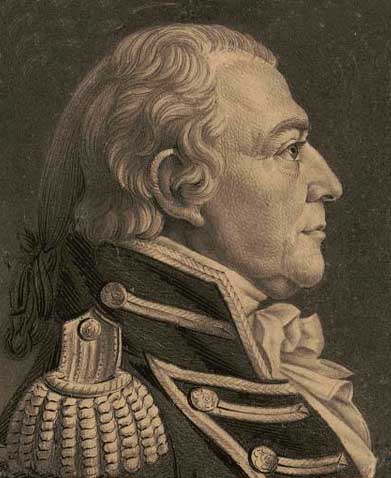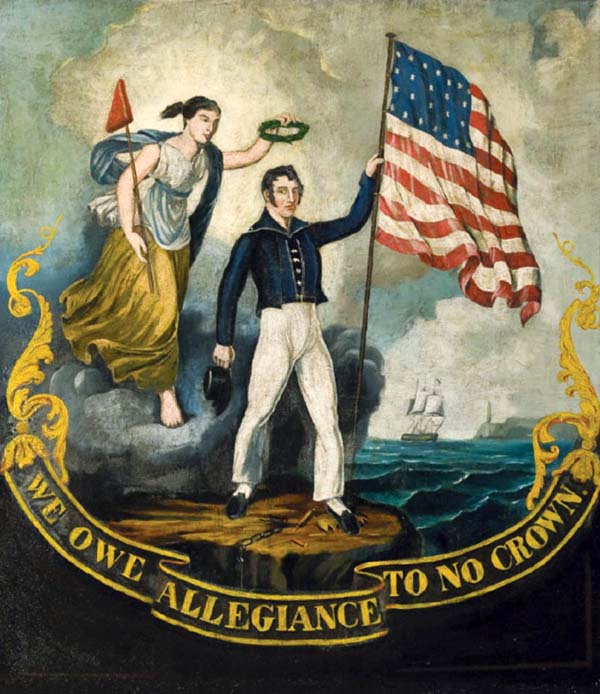The “Tar and Feathers Company” Memorial (Petition) to Secretary of Navy, Robert Smith,
from 72 Washington Navy Yard tradesmen, 10 November 1808
By John G. M. Sharp
At USGenWeb Archives
Copyright All right reserved
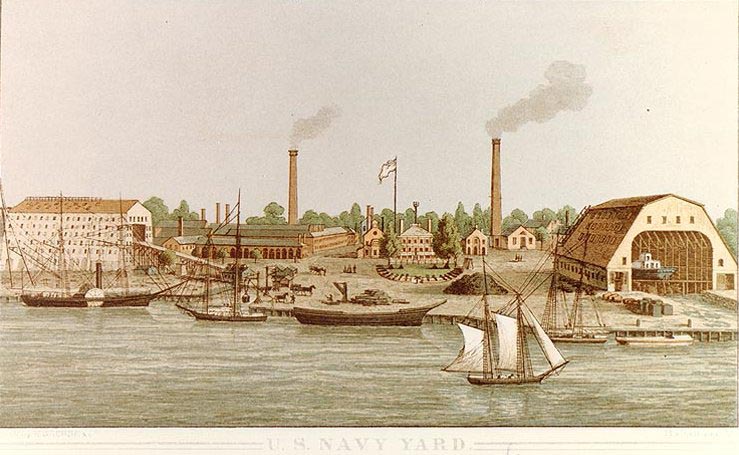
1861 Currier and Ives
lithograph of the Washington Navy Yard
Introduction: In 1808, Samuel Hanson of Samuel (1752-1830) the Washington Navy Yard’s purser, brought charges against Captain Thomas Tingey (1750-1829) and his deputy Master Commandant John Cassin (1760-1822). In November 1808 Hanson also charged that numerous Washington Navy Yard civilian tradesmen had organized themselves into a “Tar and Feathers Company” that was a threat to public order. Hanson claimed,
The avowed object of their association, which was to be permanent, was the Tar & Feathering of certain characters obnoxious to them in and about the Yard. The Tar and Feathers Club had threatened William Prout and other wealthy Federalists by parading outside his home, loudly accompanied by a Barrel of tar was actually procured and a corresponding of Feathers taken in procession, and in open day to the House of the Overseers of the Yard where it was deposited with the honor of 3 Cheers. This ceremony was performed just opposite the Store of Mr. [William] Prout, one of the Mediated victims of this lawless project.1 Prout’s business and commercial success made him a powerful figure. For instance, Prout sat on the board of the Washington Commercial Company. The company Board of Directors included Thomas Tingey, James Cassin and James Smallwood the future mayor of Washington DC.2
1. William Prout (1753-1823) was a wealthy English immigrant, a business man, slaveholder and Federalist who made fortune in land speculation. Prout was thought by many Navy Yard workers to be pro-British and a monarchist. Prout’s business and commercial success made him a powerful figure. For instance, Prout sat on the board of the Washington Commercial Company. The company Board of Directors included Thomas Tingey, James Cassin and James Smallwood the future mayor of Washington DC.
2. 16 May 1808, National Intelligencer, (Washington, DC), p. 3.
In their petition to Secretary of the Navy, Robert Smith, the now contrite Navy Yard workers admitted they had demonstrated against certain alleged pro-British Tories and did on or about the first day of July 1807 procure an empty Tar Barrel and wrote with chalk upon the Head [had written] Tar for Tories 1776. They further noted they had, deposited [the barrel] at the House of Ralph Charlton in the vicinity of the Yard under the idea of it being full of Tar… Ralph Charlton was a businessman who operated a store near 7th Street and the Navy Yard. His store sold bottled cider, porter and porter ale. He also sold Virginia crab and other food stuff.3
3. 23 October 1807, National Intelligencer, (Washington, DC), p. 4.
Another person shipyard workers felt was too close to Great Britain was Josiah Fox, Naval Constructor. They claimed Fox was well known as being the enemy of the whole establishment at this place. Tarring and feathering was a form of public torture and punishment used to enforce unofficial justice or revenge. As a successful immigrant from England who was a Quaker and moreover an ardent Federalist, for the workers Josiah Fox became a natural target. This and the fact that he had made a successful career as a Naval Constructor (Naval Architect) made him the focus of worker resentment.4 By 1808 his salary as constructor for the Washington Navy Yard increased to $2000.00 per annum with $500.00 additional allowance for housing, and the liberty of taking as many apprentices as he chose. Fox by 1807 had seven apprentices; five white, whose families paid him a commission to teach their sons the difficult and lucrative trade of shipbuilding. He was, furthermore, a slaveholder with two enslaved men who he was training as ship carpenters and whose wages he collected. Fox’s teaching his enslaved black apprentices such a skilled trade was deeply resented by white workers.5
4. Brown, Gordon S., The Captain Who Burned His Ships: Captain Thomas Tingey, USN, 1750-1829 ( Naval Institute Press: Annapolis, 2011) pp. 76–78.
5. Sharp, John G. M., Josiah Fox (1763-1847) Naval Architect
The Chesapeake/Leopard Affair mentioned in the employee petition took place on 22 June 1807. This dramatic incident, the impressment of four American seamen from the USS Chesapeake, caught public attention. The British vessel HMS Leopard had boarded the Chesapeake and seized four seamen they claimed were deserters and were British-born consequently, they alleged, subject to impressment in the British Navy. Americans treated this event as a national insult and both Federalist and Democrats stoked the fires of nationalism.6 This 1807 episode was the proximate cause for the creation of the Tar and Feathers Club.
6. Cray, Robert E. Remembering the USS Chesapeake: The Politics of Maritime Death and Impressment. Journal of the Early Republic, vol. 25, no. 3, 2005, pp. 44, JSTOR, http://www.jstor.org/stable/3004333. Accessed 14 July 2023.
In late 1808 Samuel Hanson wrote to Secretary of the Navy, Robert Smith, to demand a public investigation into the official conduct and alleged misdemeanors of Commodore Thomas Tingey and Master Commandant John Cassin. Samuel Hanson had written to Smith about the Tar and Feather Club:"
It is an undoubted fact that some weeks ago… Workmen of the Yard embodied themselves into a Society, chose their officers and contributed each a certain sum for the establishment of a fund. The avowed object of their association, which was to be permanent, was the Tar & Feathering of certain characters obnoxious to them in and about the Yard. How far the jurisdiction of this Plumy Tribunal was to extend does not appear.
Hanson wanted a public inquiry. An angry Thomas Tingey likewise proclaimed his ardent desire to clear his name and demanded a public inquiry into Hanson’s conduct and activities as purser for the Navy Yard.7 On 4 November 1808, Hanson wrote Thomas Jefferson listing the names of the men he considered the leaders of the “Tar Company” who he alleged were a threat to public order. 7a
7. Brown, p. 65.
7a. Samuel Hanson to Thomas Jefferson, 4 November 1808, Historical Society of Pennsylvania, Daniel Parker Papers
It is a fact, Sir, that three officers of a Militia Company, called The Volunteer Rifle Company, are leading members of the Tar Company (the Title) members of the same formed more than 4 months ago, at the Navy Yard!
Their Names are:
Wm Smith, Capt.
Jno Davis of Abel, Lieutenant
David Dobbins, Lieutenant
These men as living within the District have been honored with commissions immediately from yourself. One of the threatened is Wm Prout…
The Chesapeake–Leopard affair had heighted political tensions in the nation. Many of the Washington Navy Yard mechanics and laborers were former sailors who deeply resented the impressment of American Seamen. The events of 1807 were seen as a humiliation both by the Naval Officers and the Navy Yard workforce. Many of whom believed they had cause to chastise those they thought were not sufficiently patriotic.
Among the seamen impressed from the USS Chesapeake was William Ware a formerly enslaved Black man who was born near Pipe Creek, Fredericks County, Maryland. Ware served first on the commercial brig Neptune and later served eighteen months on the USS Chesapeake under Captain James Barron. He is described as “an Indian looking man.” John Strachan was born in Queen Anne’s County, Maryland, and had served on the merchant brig Martha Bland. He is described as a “white man about 5 feet seven inches high.” Daniel Martin and William Ware as blacks were not citizens and consequently are described as “native” Americans. The three American tars Martin, Ware and Strachan were court-martialed in Halifax, Nova Scotia, and each sentenced to 500 lashes but the penalty was later remitted. Jenkin Radford as British subject and deserter was tried by court martial and sentenced to death. He was executed at Halifax on 31 August 1807.
Seamen's Protection Certificates were authorized by the Fourth Congress on May 28, 1796, to protect American merchant seamen from impressment. However, these certificates were often ignored by British officers. At the time the American seamen of the USS Chesapeake were impressed, William Ware and Daniel Martin, each said they had their protection certificate. John Strachan claimed he had left his aboard the frigate. Nevertheless, the British officers simply ignored their claims.
Daniel Martins's Protection Certificate
(click to enlarge)Among the Navy Yard employees there was widespread sympathy for the impressed sailors. Washington Navy Yard Commandant Thomas Tingey himself, had firsthand experience and was perceived as sympathetic to their plight for while commanding the sloop of war USS Ganges (24 guns) on 8 January 1799, his vessel was hailed and boarded one day by officers of the British frigate HMS Surprise, a more powerful ship. A Royal Navy Lieutenant came on the sloop and questioned Tingey whether he had any British subjects aboard and requested to examine the crew’s protections.* In his 18 February 1799 letter to Secretary of the Navy, Benjamin Stoddard, he recounted the incident and his response.
* Brown, Gordon S. The Captain Who Burned His Ships Captain Thomas Tingey, USN, 1750 -1829 (Naval Institute Press, Annapolis, Maryland, 2011), pp.29 – 30
One Circumstance occur’d during the cruise of the Ganges, Which I conceive you ought to be acquainted with, and the reasons why I omitted communication thereof in correspondence from St. Thomas; may perhaps be thought to require explanation – in the first place it was a subject; I did not think right to inform of by a conveyance wherein there might be the least requisite of the falling into improper hands – and secondly, I saw by the American paper at St. Thomas that an actual case in point was before Congress – I mean the right which some of the British Commanders conceive they had to search our public ships for their seamen.
One of the frigates I fell in with [HMS Surprise], sent an officer on board to enquire on this subject observing at the same time that my assurance would be sufficient to prevent an officer being sent to examine the protections of my crew – I did not hesitate to say I considered all my crew Americans born or adopted – But I told the officer further, that I did not believe there was one single protection in the Ship – that only nine were carried in our public ships bearing our Flag - This business subsided here, and the rest of our intercourse was friendly .
But I had declared to my officers that I would fall at post rather than submit to an investigation and afterwards pledged myself to my Crew, that not a man of them should be taken from me, while I was able to stand at my quarters.’ It is incumbent to know how far I should be justified in repelling force by force on such an occasion. **
** Wolf, Joshua J., “The Misfortunate to Get Pressed:” The Impressment of American Seamen and the Ramifications on the United States, 193 -1812, Temple University, PHD, Dissertation, 2015 https://scholarshare.temple.edu/bitstream/handle/20.500.12613/4048/TETDEDXWolf-temple-0225E-12189.pdf?sequence=1&isAllowed=y
Thomas Tingey, 1806
by Charles Balthazar de Saint Memin LOCWhen he arrived in Norfolk, Virginia, Captain Tingey learned his encounter with HMS Surprise was widely covered in the press. As he noted these accounts differed markedly and were often inflated, while others badly misrepresented the essential facts. As soon as possible, he wrote to the printers of the Norfolk Herald, to once again state what had occurred and what he had in his report to the Secretary of the Navy.
GENTLEMEN, EVER an enemy to misrepresentation, I must beg you to correct the statement of the transaction between his Britannic Majesty's ship Surprise of 32 guns, and the United States' ship Ganges under my command. It is true in my crew; observing that my assurance would be sufficient to prevent an officer being sent to examine their protecti, that Captain Hamilton of the above ship did send an officer on board requesting information, whether any Englishmen were onboard, I did not hesitate to say I considered all my crew Americans by birth or adoption - But I also observed to the officer, that there were no protections on board to my knowledge -the only one we carried in our public ships being our flag. This business terminated here. It is not true that the officer demanded a sight of my commission; but during his stay behaved with much politeness, and was in return, treated with all the civility I was capable of. Nor did I, as I have heard it represented, say anything about my guns being a protection if my flag was deemed insufficient. As soon as the boat put off a second time to come on board the Ganges, being on the quarter deck with my officers, I declared to them my determination to fall there, sooner than suffer an investigation, or permit any man's name to be called over. When the boat came along side again, it was with the surgeon; and with a polite message from Captain Hamilton requesting to assist him with some medicine he was in need of. But no mention was made for the message sent by the Lieutenant; no subject thereof even mentioned by the doctor or myself. Apprehensive that a similar circumstance might occur on a future day, I thought it incumbent on me to let my people know what they had to trust to. At evening, therefore, I caused all hands to be called and when assembled, did pledge myself to them, that not a man should be taken from me, by any force whatever, while I was able to stand at my quarters - which declaration they received with three cheers, and high spirits. Thomas Tingey , Norfolk, 27 February 1799
One of the most outspoken was John Davis of Abel (1774-1853) a former sailor and a leader in the “Tar Company”. In the 1806 sketch of John Davis of Abel, (above) he still wore his hair sailor style in a queue. Davis had served in the merchant vessel Fidelity in 1791 and was with her in the port of Martinique where their ship was surrounded by a British press gang. Davis and other American seamen were forcibly taken and conveyed to the HMS Ceres. There they were accused of being British citizens and told they were to be forcibly conscripted. Those liable to impressment were "eligible men of seafaring habits between the ages of 18 and 55 years. A conservative estimate of the number of American seamen impressed from 1796 to January 1812 is 9,991, a figure which compensates for duplications of names as they were found in lists made up by the Department of State and American agents for seamen in England. The most severe period was that from 1803 to 1812 when some 6,000 seamen were impressed. Not more than one third of them were released before the outbreak of the war. Contemporary estimates ranged from 10, 000 to 50,000. Realistically speaking, however, it is still provocative to think that probably 750 to 1,000 were impressed annually between 1808 and 1812.8
8. The Naval War of 1812: A Documentary History 1812 Vol. 1 William S. Dudley editor (Naval Historical Center: Government Printing Office1985), p. 62.
Davis was fortunate as he was finally released but as he made clear, the majority of those taken were placed into the crew of the British ship.9
9. 19 October 1813, Mercantile Advertiser (New York, N.Y.), p.2
Tarring and feathering was a much feared form of public torture, punishment and humiliation and often used to enforce unofficial justice or revenge. The victim would be stripped naked, or stripped to the waist. Wood tar (sometimes hot) was then either poured or painted onto the person while they were immobilized. The victim then either had feathers thrown on them or was rolled around on a pile of feathers so that they stuck to the tar. Incidents of taring and feathering occurred in American cities during this period. In one dramatic incident at Baltimore in October 1808, a shop owner was seized, placed in a cart covered with tar and feathers and paraded through the streets to Fells Point and back. This and other such occurrences were widely reported and clearly alarmed property owners.9a
9a. 29 October 1808, Monitor, (Washington, D.C.), p.1
A frustrated Smith, wrote to remind all three men:
Whatever accusations you may have against any officer or officers of the Navy Yard at Washington, you will further with exhibits of the same with the necessary evidence in support thereof in order that the whole might be submitted to the consideration of the President.10
10. Robert Smith, Circular Letter to Thomas Tingey, John Cassin and Samuel Hanson, 17 September 1808, Miscellaneous Records of the Navy Department, Letters, 1808, p. 45, Roll 0175, RG 45, National Archives and Records Administration, Washington, DC.
After looking over the respective allegations of Hanson, Tingey and Cassin, Robert Smith in dismay wrote to President Thomas Jefferson on 3 November 1808, The accompanying papers exhibit the melancholy remark of Erasmus, Homo homini lupusest (Man is wolf to man).11
11. Robert Smith to Thomas Jefferson 3 November 1808, retrieved from the Library of Congress, www.loc.gov/item/mtjbib019273/
Jefferson responded to Hanson’s accusations that a Navy Yard Company of workers had threatened wealthy Federalist William Prout by parading outside his home, loudly accompanied by barrel of tar. Jefferson quickly wrote General Henry Dearborn, forwarding Hanson’s complaint and directed:
These officers should be warned that the Executive cannot tamely look on & see its officers threaten to become the violators instead of the protectors of the rights of our citizens. I presume, however, that all that is necessary will be that their commanding officer (General Mason) finding the fact true, should give them a private admonition, either written or verbal as he pleases, to withdraw themselves from the illegal association.12
12. Thomas Jefferson to Henry Dearborn, 5 November 1808, Historical Society of Pennsylvania, Daniel Parker Papers.
The Navy Yard workmen realized their parade through the streets of the District with threats to tar and feather Tories was seen as both a threat to property and civil order. The tone of their memorial petition reflects they were aware they may have exceeded Secretary Smith and President Jefferson’s patience. Hence, they carefully crafted their 10 November 1808 petition to Smith disavowing any resort to violence and to stress their new abhorrence of extra judicial punishment, their patriotic support for law and order and desire to live in peace.
Your memorialist will conclude by stating their motives were no other than a desire to live in peace with all men and a consciousness of having been wrongfully traduced and that they have no wish to overawe or dictate to others.President Jefferson’s direction to Smith, to insure the Navy Yard workmen had a private admonition, was followed and the inquiry into the conduct of Tingey, Cassin and Hanson was quietly placed in the files of the Department of the Navy where it has sat for the last two centuries. For most Americans, the Chesapeake Affair was about impressment. While temporarily chastened public anger over the issues of impressment, “sailor’s rights” well as disagreements over trade would continue to quietly simmer only to arise on a national level in the War of 1812.13, 13a
13. Hickey, Donald R., The War of 1812: A Forgotten Conflict (University of Illinois Press, Springfield, 2012),
pp. 12-13.13a. Gilje, Paul A., Free Trade and Sailors Rights in the War of 1812 (Cambridge University Press, New York, 2013), p.181
We Owe Allegiance to No Crown
John A. Woodside, 1814, National Portrait GalleryTranscription. This transcription was made from digital images of case number 55, 1808, Records of General Courts Martial and Courts of Inquiry of the Navy Department, 1799-1867, regarding Thomas Tingey, John Cassin and Samuel Hanson of Samuel. The original petition and list of 72 employees were interfiled with other documents as part of the 1808 Court of Inquiry regarding Tingey, Cassin and Hanson. The memorial (petition) to the Secretary of the Navy, with an accompanying list of 72 Navy Yard employees’ names, can be found in pp. 5-11.14 These documents are located in the National Archives and Records Administration, Washington, DC.
14. Navy Court Martial Records and Court of Inquiry, 1799-1867, re Thomas Tingey, 10 Nov 1808, List of names and memorial addressed to Robert Smith pp. 5-11, Volume 2, Case number 55, Case Range, 30-74, Year Range 16 Oct 1805 to 16 Jan 1810, Roll 0004, National Archives and Records Administration, Washington, DC.
Dedication: This is for my great great great-grandfather David Megill (1753 - 1807) of Kirkcudbright, Scotland. About the time of the American Revolution, David was forcibly impressed into the Royal Navy. Seizing an opportunity, he jumped ship in New York harbor and became a successful farmer.
John G.M. Sharp 21 August 2023
* * * * * *
Memorial of Sundry Person at the Yard Nov. 10, 1808
To the Honorable Robert Smith Secretary of the Navy
The memorial of Sundry person’s tradesmen whose names are herewith transmitted respectfully showed –That your memorialist having been informed that certain charges, wanton and malicious in the highest degree, have been alleged against them by certain persons to them unknown, otherwise than by conjecture which charges, though false, have a manifest tendency to injure and destroy their characters as citizens & must, if believed, induce a belief of their having deviated from that respect that they feel for the Laws and Government of the country. And that trusting to your well known candor and for the attention you have been over ready to render them, they beg leave to offer a simple narrative of occurrences, which heightened by public statements, have been alleged to against them. To which they should have left unnoticed to such into contempt with other lies of the day. As those misrepresentations have lain before you as subjects of complaint against your memorialist –
Your memorialist therefore calls your attention to the month of July 1807 and to the patriotick sensation so generally felt by all Americans at the unhappy affair of the Chesapeake…1515. On 22 June 1807 frigate USS Chesapeake was fired upon by HMS Leopard of the Royal Navy for refusing to allow a search for deserters. The event, now known as the Chesapeake–Leopard affair, angered the American public and government and was a precipitating factor that led to the War of 1812. As a result of the affair, Chesapeake's commanding officer James Barron was court-martialed and the United States instituted the Embargo Act of 1807 against the United Kingdom. See Sharp, John G. M., American Seamen’s Protection Certificates & Impressment 1796-1822. http://www.usgwarchives.net/va/portsmouth/shipyard/sharptoc/aspc&i.html
At this time participating deeply in the so generally expression sense of their county and feeling indignant at the calumnious and base expressions they were daily in the hail of hearing hurled against themselves and their country at large and knowing that the Law offered no check to such licentious tongues, you memorialist devised the following plan, by which to shame those persons and at the same time to avoid any infractions of the Laws of this country for which they have always evinced the highest veneration.. A number of your memorialists did on or about the first day of July 1807 procure an empty Tar Barrel and wrote with chalk upon the Head Tar for Tories 1776 that they deposited at the House of Ralph Charlton in the vicinity of the Yard under the idea of it being full of Tar…
Though forbidden by Law, his conscience must have been convinced he justly merited these clamorous were hushed and all the effect desired being answered, the whole sunk in oblivion and might so have been vested had it not been for the exertions we are led to believe of Mr. Josiah Fox, Naval Constructor, who is well known as being the enemy of the whole establishment at this place and is believed on good grounds eagerly on it as an additional reason for vilifying the Navy Yard from hence and whose unfounded assertions to the disadvantage of the place can be substantiated by Mr. Thomas Carberry…16, 17
16. Sharp, John G,M., Josiah Fox, Naval Architect 1763 -1847 http://www.usgwarchives.net/va/portsmouth/shipyard/sharptoc/jfox.html
17. Thomas Carbery (or Carberry) (June 26, 1791 to May 23, 1863) was the sixth mayor of the City of Washington (now Washington, DC.), serving from 1822 to 1824.
The assertions which have been made of Lists having been made out of persons to be Tarred and Feathered, we do not hesitate to pronounce a willful malicious and infamous falsehood -
That as the period was approaching when the elections in the different States from whence we originally removed to this place we were generally known to have our wishes for the success of those principles to which we were attached, this has laid hold of to throes our guard in a variety of way and to induce us to commit ourselves by some rash act by persons who are known to British Subjects those clamorous were at their highest upon the arrival of a French Brig at the Navy Yard and their Malice has no bounds – …
In order to counteract this insolence in some measure a proposal was made by some of your memorialist on or about the 18th July last to revive the Tar barrel in the hope to be some check, but as the scheme which took place with an empty barrel would have lost its force. A proposal was made to purchase a full one, some contributed $2.50 each and after 7 or 8 had done so it was concluded among dissenters to keep an account of the money alone as most of the contributions were withdrawn in this manner, about $5 was offered and one barrel of tar purchased.
This your memorialist solemnly declares before God was the whole truth what has been declared a nefarious and diabolical association whose officers are said to be appointed and whose prescription lists are said to be filled with the names of the most worthy citizens…
They beg leave to state that the unfortunate barrel aforesaid was left at the House of Mr. David Dobbins, a Public House near the Navy Yard, a House resorted to by many of your memorialists in the intervals of their labors, until the said Dobbins removed his residence to another House in the vicinity.18 He therefore in the beginning of the last year caused a notice to be put up on a Post in the Publick House which is the usual place of all advertisements, requesting in an Ironical though innocent manner the contributions of the aforesaid to remove the barrel. Mr. Fox it appears tore down the notice and has poured forth against your memorialist, malignant assertions which appear to the every unprejudiced observer to be unfounded.
18. David Dobbins, Unk-1816, was a fixture in the early Washington Navy Yard, where he worked for some years as 2nd Overseer of Laborers. The date of Dobbins birth is unknown. Dobbins name is enumerated on the 1808 list of employees as Daniel Dobbins, he was paid 1.50 per day. See http://www.genealogytrails.com/washdc/WNY/wny1808rif.html
Dobbins was a Lieutenant in the Militia of the District of Columbia. Service in the District militia was without pay, but provided the officers valuable social and political connections. Duties and responsibilities were not onerous but they did require members to drill for a set number of days per month. Dobbins last will and testament confirmed he was a slaveholder with two enslaved individuals, Moses and Sam. District of Columbia Will Book No. 2 Folio 6.7, deposited in the Registers Office, 9 February 1816.Your memorialist further observe that Saml Hanson of Saml Esqr Purser of the Yard offered affixed to the Bellpost of the Yard on Saturday last an advertisement offering in his name a reward of twenty Dollars for the Discovery of the author. What were Mr. Hanson’s motives for this we are unable to tell without Mr. Fox in his usual dexterous manner distorting the facts had he succeeded in alarming the fears of Mr. Hanson as he had heretofore done with sundry previous avowed enemies of the Government and hardy advocates of foreign aggression? However, Mr. Dobbins immediately went to Mr. Hanson and avowed himself the author that no person should lay under censure, however undeserved -
He also declared to Mr Hanson his firm belief that no injury was or ever had been contemplated by himself or any person to his knowledge against Mr. Hanson …
That your memorialist, having reason, believe that attempts were made to prejudice your mind against them, holding a meeting on Monday in order to counter such attempts against their character. Mr Hanson they are sorry to observe to the cause of calumny by calling on the Police Officers of the City to attend and disperse them, telling them that the Tar and Feathers Club were met and some atrocious outrage was to apprehend as we hold it to be an untroubled right peacefully to assemble for lawful purposes, we cannot but view such conduct as an assumption of power not delegated by the laws of our Country to any person and little did we expect such conduct in him, we have always being of Republican principles …
That the situations in life of your memorialists and their necessary daily avocations prevent them from having the access as have in the reach of their calumniators tho after deliberations have adopted this manner of introducing themselves and their cause to your notice, trusting in your candor to excuse as their misfortune not their fault any want of language or want of respect in their narrative-
They have therefore transmitted the list of their name for your information, fully convinced that when the whole facts are weighed and it is seen how the whole fabric of misrepresentation, and when it is seen instead of being a lawless rabble that the greater part of us have families, wives & children dependent on us to support and comfort and that the great many of us have invested our little all and involved ourselves in debt for that purpose so we are most powerfully interested in the preservation of order, when it is seen that in that number are men whose Heads are bleached by the Hands of time and who have fought and bled in the battles of our Country, it is impossible your memorialists would fondly hope you could for a moment suppose them guilty of the charges alleged against them -
Your memorialist will conclude by stating their motives were no other than a desire to live in peace with all men and a consciousness of having been wrongfully traduced and that they have no wish to overawe or dictate to others, let their opinions be what they may and have only been compelled in their view now exculpating [illegible] persons by name and that they disdain any idea of criminating any person further than necessary in their own defense. To mention the supposed motives of their accessors, they therefore with confidence submit themselves to your Liberality & hope not to have trespassed too long on your attention.
A List of WNY Names
(p. 5 & 6)
John Davis of Abel Joseph Porter Peter Pravote Geo Percy Saml Young William Hollenbeck David Dobbins Saml Rodger John Williams W. McKey John Cummins Joseph Herbert Walker Turner J Dreskill William Dyson Thomas Murray George Grant John Barnes Jesse McCoy Cornelius Cohoon John Minitree James Boddington Wm Lambell Benjamin King Junr Thomas Summers Wm Handen William Whaley William Smith John Anderson Thos Penn Edward Bland John Selater Daniel Bourne Nicholas Harper John Nicholson Thos Young Thos Howard Wm Gillett Robt Mc Clennen George Barnes William Wells Edward Linscott John Davis Wm Thompson Saml Lyeres James Kemp John Felt William Peter George Lake Saml Winter Thos Jarvis Mc Cauley Haynes John Lynch Henry Mc Coy George Cox Thomas Hunter Richd Ohare Edward Grant Joseph Skill William Adams Samuel Townsend Edward Gottuer Charles Stevens Elihu Hughes Henry Allen Benjamin King Thomas Allen Colmer Bean Holder Spooner Peter Joseph Michael Cummins Michael Quigley * * * * * * * * * *
John "Jack" G. M. Sharp resides in Concord, California. He worked for the United States Navy for thirty years as a civilian personnel officer. Among his many assignments were positions in Berlin, Germany, where in 1989 he was in East Berlin the day the infamous wall was opened. He later served as Human Resources Officer, in South West Asia (Bahrain). He returned to the United States in 2001 and was on duty at the Naval District of Washington on 9/11. He has a lifelong interest in history and has written extensively on the Washington, Norfolk, and Pensacola Navy Yards, labor history and the history of African Americans. His previous books include African Americans in Slavery and Freedom on the Washington Navy Yard 1799 -1865, Morgan Hannah Press 2011.
History of the Washington Navy Yard Civilian Workforce 1799-1962, 2004.
https://www.history.navy.mil/content/dam/nhhc/browse-by-topic/heritage/washington-navy-yard/pdfs/WNY_History.pdf
and the first complete transcription of the Diary of Michael Shiner Relating to the History of the Washington Navy Yard 1813-1869, 2007/2015 online:
https://www.history.navy.mil/research/library/online-reading-room/title-list-alphabetically/d/diary-of-michael-shiner.html
His most recent work includes Register of Patients at Naval Hospital Washington DC 1814 With The Names of American Wounded From The Battle of Bladensburg 2018,
https://www.history.navy.mil/research/library/online-reading-room/title-list-alphabetically/r/register-patients-naval-hospital-washington-dc-1814.html
The last three works were all published by the Naval History and Heritage Command. John served on active duty in the United States Navy, including Vietnam service. He received his BA and MA in History from San Francisco State University. He can be reached at sharpjg@yahoo.com
